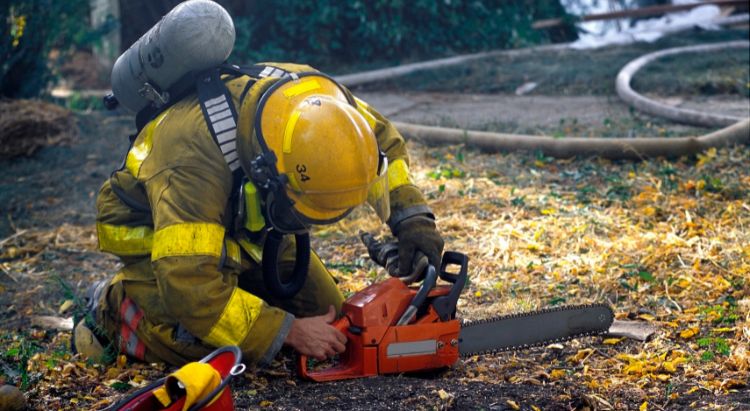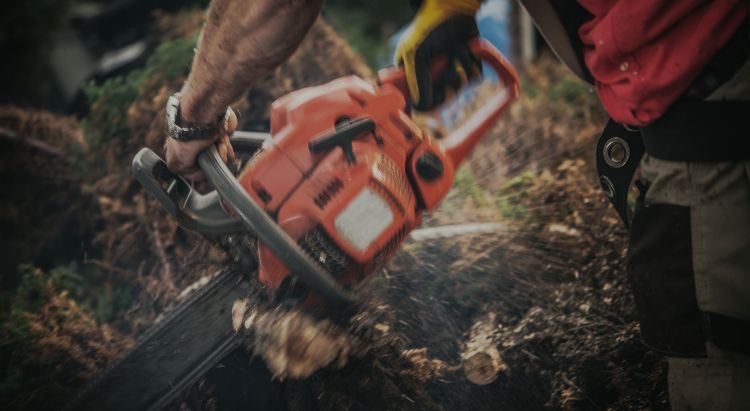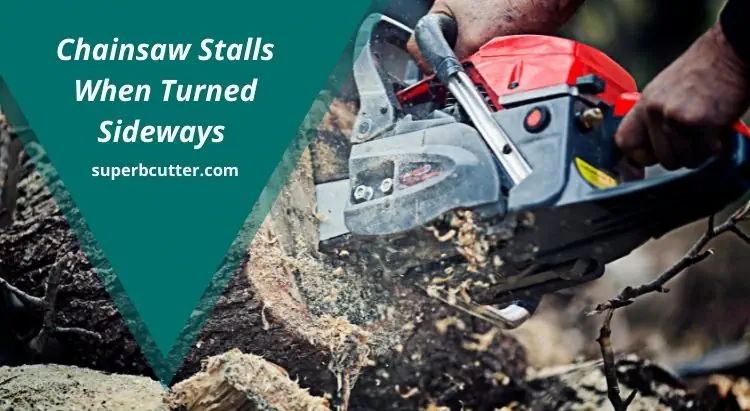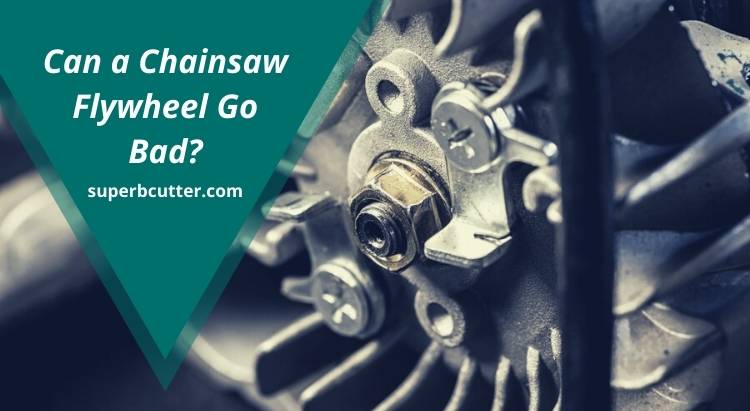What Chainsaws Do Professional Loggers Use?
Chainsaws are one of the most important tools in the logging industry, used for felling trees, cutting them into logs, and preparing them for transport.
For professional loggers, having the right chainsaw can significantly improve their productivity, safety, and overall success. This article will explore what chainsaws do professional loggers use and why they need specialized tools to get the job done.
Whether you’re a seasoned logger or just curious about this essential tool, keep reading to discover the best chainsaws for professional use and how they help loggers work efficiently and safely in the field.

Types of Chainsaws:
Chainsaws come in three main types: gas-powered, electric, and battery-powered. Each type of chainsaw has unique advantages and disadvantages and is suited for different applications depending on the user’s needs.
Gas-powered chainsaws:
Gas-powered chainsaws are known for their high power output and are popular among professional loggers.
They run on a mixture of gasoline and oil and are equipped with two-stroke engines.
They are ideal for heavy-duty cutting jobs such as felling large trees and can easily handle tough materials.
Advantages:
- High power output for heavy-duty cutting
- Ideal for outdoor use
- It can be used in remote locations where electricity is not available.
Disadvantages:
- Require more maintenance than electric or battery-powered chainsaws
- It can be heavier and more difficult to handle
- Noisy and produce emissions
Popular models among professional loggers:
- Husqvarna 460 Rancher: This gas-powered chainsaw is a favorite among professional loggers due to its power, durability, and easy handling. It has a 60.3cc engine and a 24-inch bar, making it ideal for felling large trees.
- Stihl MS 880 Magnum: Another popular gas-powered chainsaw among professionals, the Stihl MS 880 Magnum is known for its power and durability. It’s 121.6cc engine and 47-inch bar make it ideal for heavy-duty cutting jobs.
Electric chainsaws:
Electric chainsaws are powered by electricity and are ideal for light to medium-duty cutting jobs. They are quieter, require less maintenance, and are more environmentally friendly than gas-powered chainsaws.
Advantages:
- Quieter and produce no emissions
- Require less maintenance than gas-powered chainsaws
- Lightweight and easy to handle
Disadvantages:
- Require a power source, limiting their use to areas with access to electricity
- Less powerful than gas-powered chainsaws, limiting their use to light to medium-duty cutting jobs
- Not ideal for outdoor use in wet or rainy conditions
Popular models among professional loggers:
- Oregon CS1500: This electric chainsaw is popular among professional loggers due to its power, durability, and ease of use. It features a 15-amp motor and an 18-inch bar, ideal for light to medium-duty cutting jobs.
- Makita UC4051A: Another popular electric chainsaw among professionals, the Makita UC4051A is known for its power and durability. It has a 14.5-amp motor and a 16-inch bar, which is ideal for light to medium-duty cutting jobs.
Battery-powered chainsaws:
Rechargeable batteries power battery-powered chainsaws and are ideal for light to medium-duty cutting jobs. They are quiet, produce no emissions, and are more environmentally friendly than gas-powered chainsaws.
Advantages:
- Quiet and produce no emissions
- Lightweight and easy to handle
- Can be used in remote locations where electricity is not available
Disadvantages:
- Limited battery life, requiring frequent recharging
- Less powerful than gas-powered chainsaws, limiting their use to light to medium-duty cutting jobs
- More expensive than electric or gas-powered chainsaws
Popular models among professional loggers:
- Greenworks Pro GCS80420: This battery-powered chainsaw is a popular choice among professional loggers due to its power, durability, and ease of use. It features an 80-volt lithium-ion battery and an 18-inch bar, which is ideal for light to medium-duty cutting jobs.
- DeWalt DCCS620P1 is another popular battery-powered chainsaw with a brushless motor that delivers up to 90 cuts on a 4×4 pressure-treated pine wood with a 5Ah battery. This chainsaw has a 12-inch Oregon bar and chain for efficient and smooth cuts. Its compact and lightweight design makes it easy to handle and maneuver and is ideal for pruning and light to medium cutting tasks.

Factors to Consider When Choosing a Chainsaw
When choosing a chainsaw, several factors must be considered to find the right tool for your needs. Here are some important factors to keep in mind:
Power Output:
The power output of a chainsaw is typically measured in horsepower (HP) or cubic centimeters (cc) of engine displacement. The power output determines how quickly the chainsaw can cut through wood and the size and type of wood it can handle. Here are some things to keep in mind when considering power output:
- Higher horsepower or cc ratings generally mean more power and faster cutting speed.
- Gas-powered chainsaws typically have higher horsepower ratings than electric or battery-powered models.
- A lower-powered electric or battery-powered model may be sufficient if you use the chainsaw for light-duty work, such as pruning or trimming.
Bar Length:
The bar length of a chainsaw refers to the length of the cutting blade. Bar length determines the size of the wood that can be cut with the chainsaw. Here are some things to keep in mind when considering bar length:
- Longer bar lengths are typically better for cutting larger trees or logs, while shorter bar lengths are better for smaller trees or branches.
- Gas-powered chainsaws typically have longer bar lengths than electric or battery-powered models.
- Longer bar lengths can make the chainsaw heavier and more difficult to handle.
Weight:
The weight of a chainsaw is an important consideration, especially if you’ll be using it for extended periods of time. Here are some things to keep in mind when considering weight:
- Lighter chainsaws are typically easier to handle and maneuver but may have less power than heavier models.
- Gas-powered chainsaws are generally heavier than electric or battery-powered models.
- Consider the weight of the chainsaw to your own physical capabilities.
Durability:
A chainsaw is a significant investment, so choosing a model built to last is important. Here are some things to keep in mind when considering durability:
- Look for a chainsaw with a sturdy frame and high-quality components.
- Consider the brand reputation and customer reviews to understand how well the chainsaw holds up over time.
- Proper maintenance can also help extend the life of your chainsaw.
Maintenance Requirements:
All chainsaws require regular maintenance to keep them running smoothly and safely. Here are some things to keep in mind when considering maintenance requirements:
- Gas-powered chainsaws require more maintenance than electric or battery-powered models, including regular oil changes and air filter cleanings.
- Some models may require frequent maintenance, so read the owner’s manual before purchasing.
- Consider the cost and availability of replacement parts and accessories when evaluating the maintenance requirements of a particular chainsaw.
Popular Brands of Chainsaws Used by Professional Loggers
Several top brands of chainsaws are used by professional loggers, each with its own features and benefits. Here’s a closer look at some of the top brands and their popular models:
STIHL:
STIHL is a German manufacturer of chainsaws and other handheld power equipment. The company was founded in 1926 and has since grown to become one of the largest chainsaw manufacturers in the world. STIHL chainsaws are known for their high quality, durability, and reliability, making them popular among professional loggers.
Popular models among professional loggers:
- STIHL MS 661 C-M
- STIHL MS 880
- STIHL MS 461
- STIHL MS 362
Husqvarna:
Husqvarna is a Swedish company manufacturing outdoor power tools since 1689. The company is known for producing high-quality, popular chainsaws among professional loggers.
Popular models among professional loggers:
- Husqvarna 372 XP
- Husqvarna 365
- Husqvarna 390 XP
- Husqvarna 576 XP
Echo:
Echo is a Japanese company manufacturing outdoor power equipment since 1947. The company is known for producing high-quality, durable, reliable chainsaws, making them a popular choice among professional loggers.
Popular models among professional loggers:
- Echo CS-800P
- Echo CS-590 Timber Wolf
- Echo CS-620PW
- Echo CS-400
Point to Pounder: A survey conducted by the logging equipment manufacturer Oregon found that the most popular chainsaw brands among professional loggers in North America are STIHL, Husqvarna, and Jonsered. The survey also found that gas-powered chainsaws are the most commonly used type of chainsaw among professionals
Features to Look for in a Professional-grade Chainsaw
Regarding professional-grade chainsaws, certain features are essential for ensuring top-notch performance and durability. Here are some features to look for:
- Anti-vibration system: A chainsaw with a good anti-vibration system will significantly reduce fatigue and discomfort caused by the machine’s vibrations. This feature is especially important for loggers who use their chainsaws for extended periods of time.
- Automatic oiling system: A chainsaw with an automatic oiling system ensures that the chain is constantly lubricated, reducing wear and tear and prolonging the life of the chain.
- Air filtration system: A high-quality air filtration system helps to keep dust and debris out of the engine, preventing damage and ensuring optimal performance.
- Easy-access air filter: A chainsaw with an easy-access air filter makes maintenance and cleaning much simpler and quicker, allowing loggers to return to work more quickly.
- Ergonomic design: A chainsaw with an ergonomic design that fits comfortably in hand and reduces strain on the wrist and arm is crucial for loggers who use their chainsaws frequently.
- Adjustable chain oiling: Chainsaws with adjustable chain oiling allow loggers to customize the oil flow to the chain, ensuring that it stays lubricated and reducing the risk of damage or malfunction.
Overall, when choosing a professional-grade chainsaw, it is important to look for features that will enhance performance, reduce fatigue and discomfort, and increase the machine’s lifespan.
Chainsaw Safety Tips for Professional Loggers
Chainsaws are powerful and dangerous tools, and professional loggers must always prioritize safety. Here are some essential safety tips for using a chainsaw in a professional setting:
Proper Personal Protective Equipment (PPE)
It is important to wear the appropriate PPE when operating a chainsaw to reduce the risk of injury. PPE for chainsaw use includes:
- Helmet with ear and face protection
- Chainsaw chaps or protective pants
- Safety glasses or goggles
- Steel-toed boots with non-slip soles
- Gloves with a good grip
Safe Handling Techniques
To ensure safety while using a chainsaw, the following handling techniques should be followed:
- Always keep both hands on the chainsaw.
- Keep the chainsaw close to your body to maintain balance.
- Stand with your feet shoulder-width apart.
- Avoid overreaching or cutting above your shoulder height.
- Do not cut with the chainsaw tip as it can cause kickback.
Maintenance and Inspection of Chainsaws
Proper maintenance and inspection of the chainsaw can help prevent accidents and increase safety. The following maintenance and inspection practices should be followed:
- Keep the chainsaw sharp and well-lubricated.
- Check the chainsaw’s safety features before each use, such as the chain brake and throttle trigger lockout.
- Regularly inspect the chainsaw for any damage or wear.
Understanding the Cutting Environment
Being aware of the cutting environment is crucial to safety when operating a chainsaw. Factors to consider include:
- Weather conditions, such as wind and rain, can affect the safety of a chainsaw.
- The terrain, such as slopes or uneven ground, can affect your balance and footing.
- The location of nearby people, animals, and objects, including power lines and fences.
Safe Working Practices
Adhering to safe working practices can help prevent accidents and maintain a safe work environment. These practices include:
- Never operate a chainsaw while under the influence of drugs or alcohol.
- Always have a designated first aid kit and emergency plan in case of an accident.
- Avoid working alone, and always inform others of your location.
- Take regular breaks to avoid fatigue and maintain focus.
Professional loggers can ensure a safer and more efficient work environment by following these chainsaw safety tips.
How to Maintain a Chainsaw Like a Professional
A chainsaw is an important tool for professional loggers, and it is crucial to maintain it properly to ensure optimal performance and longevity. Here are some maintenance tips that can help you maintain your chainsaw like a professional:
- Regular cleaning: After each use, it is important to clean the chainsaw thoroughly. This involves removing debris, sawdust, or wood chips accumulated on the saw. You can use a soft-bristled brush or compressed air to remove any dirt or debris that may have accumulated on the saw.
- Sharpening the chain: A dull chain can be dangerous and cause accidents. Therefore, it is essential to sharpen the chain regularly. You can sharpen the chain using a round file, a file guide, and a depth gauge.
- Lubricating the bar and chain: A properly lubricated bar and chain can help reduce friction and extend the life of your chainsaw. You can lubricate the bar and chain by adding chain oil to the oil reservoir before each use.
- Replacing worn parts: Over time, some parts of the chainsaw may wear out, such as the spark plug, air filter, or fuel filter. It is important to replace these parts regularly to ensure optimal performance.
- Proper storage: It is important to store the chainsaw properly after each use. You can use a protective case or cover to keep the saw safe and prevent it from getting damaged. Draining the fuel and oil tanks and removing the chain before storage is also important.
By following these maintenance tips, you can keep your chainsaw in good condition and ensure that it is always ready for use when you need it.
Conclusion
So what chainsaw do professional loggers use?
We have discussed the importance of using a professional-grade chainsaw for logging and tree-cutting operations. We have also looked at the different types of chainsaws available, including gas-powered, electric, and battery-powered, and the advantages and disadvantages of each.
Additionally, we have highlighted some of the popular brands of chainsaws used by professional loggers, as well as the features to look for in a professional-grade chainsaw.
Furthermore, we have provided some essential safety tips for professional loggers and highlighted the importance of proper maintenance of the chainsaw to ensure its longevity and optimal performance.
Using a professional-grade chainsaw can be beneficial in terms of increased power, efficiency, and durability. The anti-vibration system, automatic oiling system, air filtration system, and ergonomic design are some of the features that make professional-grade chainsaws a reliable tool for heavy-duty work.
When used correctly, a professional-grade chainsaw can make logging and tree-cutting operations more efficient and safer. Proper maintenance and adherence to safety guidelines are critical in ensuring the longevity of the chainsaw and the safety of the operator.




![Why Do Chainsaws Have Spikes? - [Beginner's Guide] 7 Why Do Chainsaws Have Spikes? – [Beginner’s Guide]](https://www.superbcutter.com/wp-content/uploads/2022/07/Why-Do-Chainsaws-Have-Spikes.webp)


